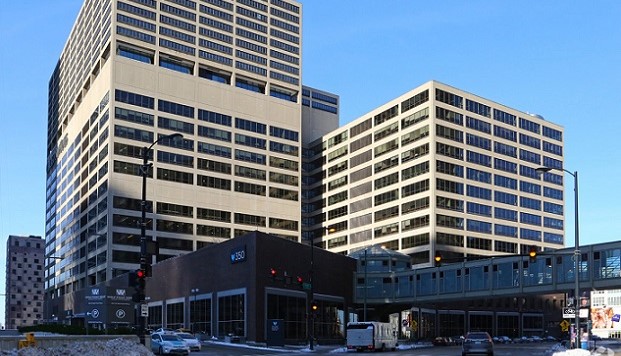 350 N. Orleans in River North.
350 N. Orleans in River North.
CHICAGO—A generation of office tenants have settled in renovated warehouses and other old industrial buildings, but the growing fondness for downtown has brought others to renovated office towers, such as Prudential Plaza, first built in the 1960s and 1970s. 350 N. Orleans, known originally as the Apparel Center, is one of the latest such projects to add a vast array of amenities and new design elements to what had been a rather non-descript building.
EQ Office, the US office portfolio company wholly-owned by Blackstone's real estate funds, bought the 1970s-era property in 2015, and began a $20 million makeover. Today, it's the kind of building that tenants like showing off to prospective employees, and helps retain existing ones.
“We recognized that the perception of the building was a little dated,” David Moore, senior vice president and portfolio director at EQ Office, tells GlobeSt.com. “It was not designed as a glitzy office building,” but behind the plain façade it provided an efficient home to apparel and textile companies who “were more focused on what was going on inside.”
Therefore, one of EQ's first tasks was to give the building a facelift. It put in windows all along the façade, which let in light and provide views of the Chicago River, something few designers considered important in the 1970s. “It was not viewed as the amenity it is today,” Moore says.
The inside was transformed as well. EQ added the River Room, an amenity lounge located near the pedway to the Merchandise Mart, that serves as a gathering place for both tenants and the public. Letting in the latter group, including many commuters fresh off the trains, is essential, Moore believes. He has been in a number of tenant lounges around the country that don't admit the public, and there “you can hear a pin drop. We're not creating a library. We want an energetic hub for the building as well as a community space.” The room also features a 1,500 square foot conference center that seats up to 100 people.
A new amenity reserved for tenants is Studio 350, a 10,000 square foot fitness space. “Instead of burying it in the basement, we put it in a prime location,” Moore says, just off the building's lobby. That makes it highly-visible, and gives its users a light-filled space with views of the river.
The company added a 5,000 square foot rooftop garden deck, but Moore says tenants are also attracted by the building's original features. They can occupy up to 44,000 square feet on one floor, or up to 88,000 between the two towers. And with large column spacing, “it's a very easy, efficient and programmable space.”
“It really hits the sweet spot of what tenants are looking for today,” he adds. “The profile of the building has dramatically increased.” EQ has done about 500,000 square feet of leasing in the last 18 months, and about three-quarters of the tenants are new to the property. Brookfield Properties, and Discover are among the most prominent occupants, which also includes growing tech firms such as Shoprunner.
“If Chicago has a tech hub, it's the Merchandise Mart,” Moore says of the property's giant next-door neighbor. And combined with the neighborhood's new luxury residential buildings like Wolf Point, this has created an intersection many firms find irresistible. “We are at the center of it all.”
© Touchpoint Markets, All Rights Reserved. Request academic re-use from www.copyright.com. All other uses, submit a request to [email protected]. For more inforrmation visit Asset & Logo Licensing.







